Top Rankings
Haliwa-Saponi Tribal School District ranks among the top 20% of public school district in North Carolina for:
Category
Attribute
Student Attention
Lowest student:teacher ratio (Top 1%)
For the 2025 school year, there is 1 public school serving 143 students in Haliwa-Saponi Tribal School District. This district's average testing ranking is 1/10, which is in the bottom 50% of public schools in North Carolina.
Public School in Haliwa-Saponi Tribal School District have an average math proficiency score of 12% (versus the North Carolina public school average of 51%), and reading proficiency score of 27% (versus the 50% statewide average).
Minority enrollment is 96% of the student body (majority American Indian), which is more than the North Carolina public school average of 57% (majority Black and Hispanic).
Overview
This School District
This State (NC)
# Schools
1 School
2,764 Schools
# Students
143 Students
1,547,014 Students
# Teachers
13 Teachers
100,085 Teachers
Student : Teacher Ratio
11:1
11:1
District Rank
Haliwa-Saponi Tribal School District, which is ranked within the bottom 50% of all 320 school districts in North Carolina (based off of combined math and reading proficiency testing data) for the 2021-2022 school year.
The school district's graduation rate of 60-79% has stayed relatively flat over five school years.
Overall District Rank
#313 out of 325 school districts
(Bottom 50%)
(Bottom 50%)
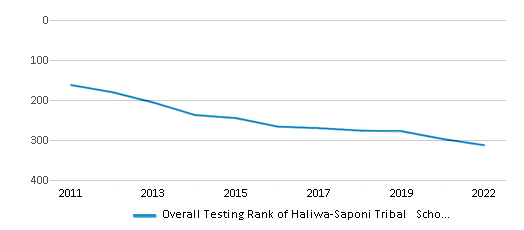
Math Test Scores (% Proficient)
10-14%
51%
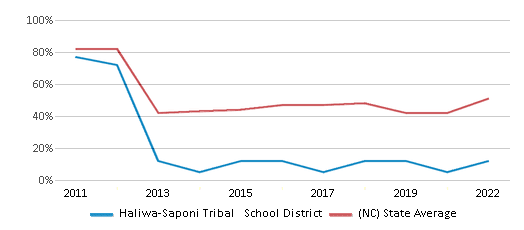
Reading/Language Arts Test Scores (% Proficient)
25-29%
50%
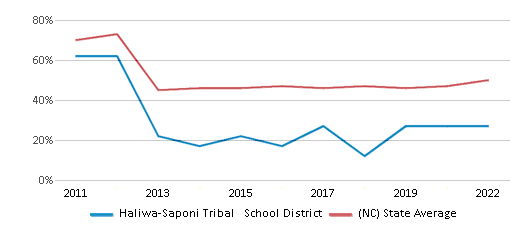
Science Test Scores (% Proficient)
40-49%
63%

Graduation Rate
60-79%
86%

Students by Ethnicity:
Diversity Score
0.60
0.71
# American Indian Students
86 Students
16,971 Students
% American Indian Students
60%
1%
# Asian Students
n/a
65,132 Students
% Asian Students
n/a
4%
# Hispanic Students
10 Students
326,941 Students
% Hispanic Students
7%
21%
# Black Students
24 Students
380,120 Students
% Black Students
17%
25%
# White Students
6 Students
665,292 Students
% White Students
4%
43%
# Hawaiian Students
n/a
2,147 Students
% Hawaiian Students
n/a
n/a
# Two or more races Students
17 Students
92,182 Students
% of Two or more races Students
12%
6%
Students by Grade:
# Students in PK Grade:
-
23,648
# Students in K Grade:
9
110,403
# Students in 1st Grade:
8
114,331
# Students in 2nd Grade:
5
118,121
# Students in 3rd Grade:
3
111,941
# Students in 4th Grade:
10
114,493
# Students in 5th Grade:
11
115,565
# Students in 6th Grade:
12
116,023
# Students in 7th Grade:
18
116,793
# Students in 8th Grade:
7
119,029
# Students in 9th Grade:
18
137,977
# Students in 10th Grade:
18
126,349
# Students in 11th Grade:
12
117,582
# Students in 12th Grade:
12
104,759
# Ungraded Students:
-
-
District Revenue and Spending
The revenue/student of $12,399 is higher than the state median of $11,187. The school district revenue/student has grown by 6% over four school years.
The school district's spending/student of $11,881 is higher than the state median of $11,612. The school district spending/student has grown by 6% over four school years.
Total Revenue
$2 MM
$17,307 MM
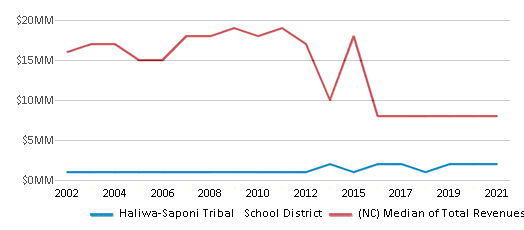
Spending
$2 MM
$17,964 MM
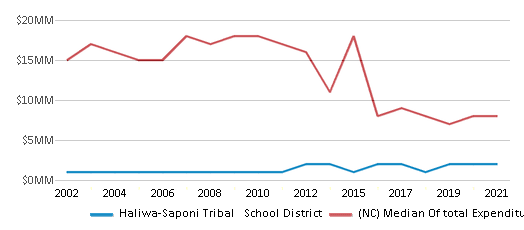
Revenue / Student
$12,399
$11,187
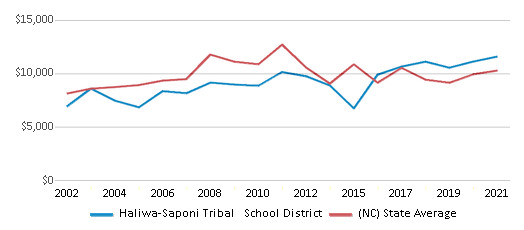
Spending / Student
$11,881
$11,612
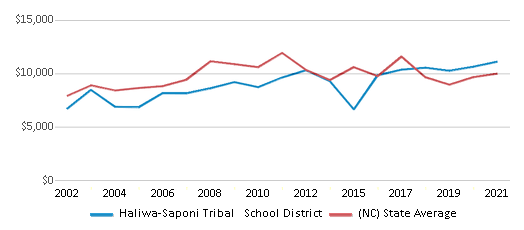
Best Haliwa-Saponi Tribal School District Public Schools (2025)
School
(Math and Reading Proficiency)
(Math and Reading Proficiency)
Location
Grades
Students
Rank: #11.
Haliwa-saponi Tribal School
Charter School
(Math: 10-14% | Reading: 25-29%)
Rank:
Rank:
1/
Bottom 50%10
130 Haliwa-saponi Trail
Hollister, NC 27844
(252) 257-5853
Hollister, NC 27844
(252) 257-5853
Grades: K-12
| 143 students
Frequently Asked Questions
How many schools belong to Haliwa-Saponi Tribal School District?
Haliwa-Saponi Tribal School District manages 1 public schools serving 143 students.
What is the rank of Haliwa-Saponi Tribal School District?
Haliwa-Saponi Tribal School District is ranked #310 out of 320 school districts in North Carolina (bottom 50%) based off of combined math and reading proficiency testing data for the 2021-2022 school year. This district ranks in the top 20% of North Carolina school districts for: Lowest student:teacher ratio (Top 1%)
What is the racial composition of students in Haliwa-Saponi Tribal School District?
60% of Haliwa-Saponi Tribal School District students are American Indian, 17% of students are Black, 12% of students are Two or more races, 7% of students are Hispanic, and 4% of students are White.
What is the student/teacher ratio of Haliwa-Saponi Tribal School District?
Haliwa-Saponi Tribal School District has a student/teacher ratio of 11:1, which is lower than the North Carolina state average of 15:1.
What is Haliwa-Saponi Tribal School District's spending/student ratio?
The school district's spending/student of $11,881 is higher than the state median of $11,612. The school district spending/student has grown by 6% over four school years.
Recent Articles

What Is A Charter School?
Explore the world of charter schools in this comprehensive guide. Learn about their history, how they operate, and the pros and cons of this educational innovation. Discover key facts about charter schools, including admission policies, demographics, and funding, as well as what to look for when considering a charter school for your child.

10 Reasons Why High School Sports Benefit Students
Discover the 10 compelling reasons why high school sports are beneficial for students. This comprehensive article explores how athletics enhance academic performance, foster personal growth, and develop crucial life skills. From improved fitness and time management to leadership development and community representation, learn why participating in high school sports can be a game-changer for students' overall success and well-being.

February 05, 2025
Understanding the U.S. Department of Education: Structure, Impact, and EvolutionWe explore how the Department of Education shapes American education, from its cabinet-level leadership to its impact on millions of students, written for general audiences seeking clarity on this vital institution.





